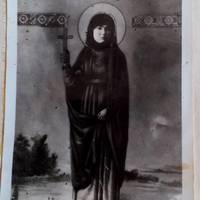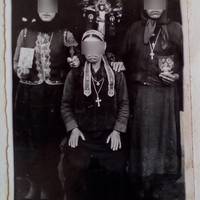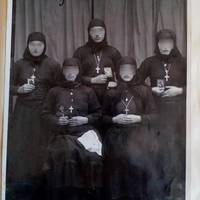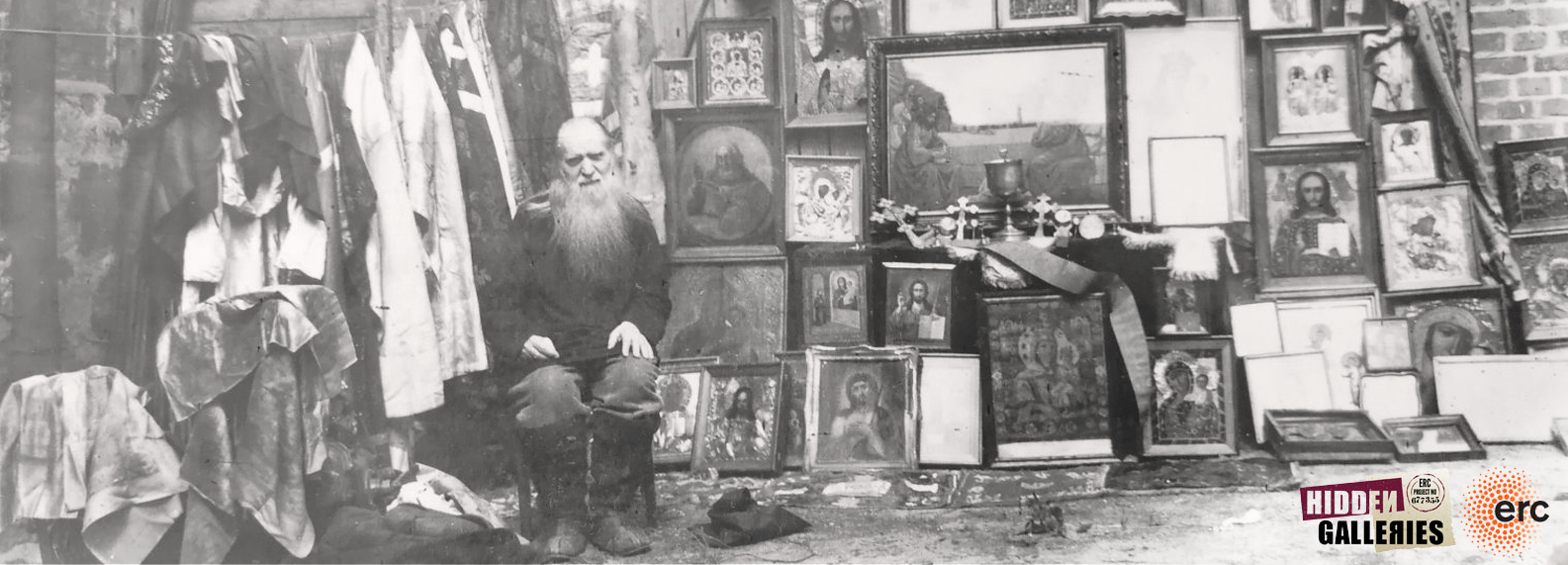Confiscated images of Archangelist women Moldova
Item
Title
Confiscated images of Archangelist women Moldova
Fotografii ale unor femei arhangheliste, Moldova
Фотографии женщин-архангелистов, Молдова
Description
These photographs were confiscated by the secret police of the Moldavian SSR from a community of Archangelists in 1952. Archangelism inherited the iconographic tradition of Eastern Christianity and developed them creatively using modern techniques of photograph, photocopying, collage and multiplication. The first image was produced using the technique of photo collage. The creator of the image has utilised a copy of an Orthodox icon showing a female saint replacing the face of the saint with a photograph of the face of Elena Culiac, venerated by Archangelists as the embodiment of Virgin Mary or the Mother of God as she is more commonly referred to in Orthodox Christianity. She was the wife of Alexandru Culiac, one of the founders of Archangelism who was considered to be the embodiment of the Archangel Michael by the believers. Above the image of Elena Culiac, there is a writing similar to that used on classic orthodox icons that praises her as a saint and as an empress. The other two photographs show two groups of Archangelist women preachers. They are dressed monastic-style robes, holding icons and crosses in a stance similar to those seen in iconographic representations of saints.
Archangelism emerged in Bessarabia from mainstream Eastern Orthodox Christianity but one of its distinctive features was the central role that women came to play. Unlike mainstream Christianity where only men can become priests, in Archangelism women hold leadership positions and officiate some religious services. The women had different roles and levels of status inside the community and these hierarchical differences are depicted in their visual representations. Elena Culiac was worshiped as the embodiment of Virgin Mary and she is represented according to sacred iconographic traditions. The first image creates a connection between these older representations of the Virgin Mary and Elena Culiac, encouraging the believer to worship her through this image. The clothes and stance of the women in the second and third photographs, who are shown standing or sitting in distinctive poses, underline their status as preachers. These icon-like images, however, do not gives them the same aura of sanctity associated with Elena Culiac. The small icons held in their hands may be intended to underline this difference. It is unlikely that these photographs fulfilled the same purpose as the photo-icon of Elena Culeac. The women depicted on the second and the third photographs were rather messengers of the embodied saints of the movement. There role was to deliver the word and the icons of the embodied saints to believers.
It is no coincidence that three of five icons held by the preachers represent Virgin Mary. The Virgin Mary is the most venerated female saint in Christianity and for Archangelist women the association with her person was the highest mark of respect and status.
Not all women in the second and in the third photographs share the same status. According to police records and as the images suggest, one of them held more authority. The women represented seating on the second photograph and sitting on the left side in the third picture held a leadership role in the community. Her status is marked by a special headscarf on the second picture, and by a handkerchief placed on her left lap on the second image. Both the headscarf and the handkerchief are decorated with crosses. On both photographs she is seated on the chair in a central position.
These confiscated photographs were used by the police as evidence of the women's involvement in an illegal sect and as a means of identification of other members of the group. Through these photographs the police tried to reconstruct the network of Archangelists in the south of the Moldovan SSR.
These photographs are attached to a secret police investigation case file created in 1952. Today the file is preserved under number 3716 at the National Archive of the Republic of Moldova, fond R-3401, inventory 1. It contains a total number of 14 photographs that include one mugshot, one picture showing confiscated religious items produced by the police and 12 confiscated photographs.
For related entries see:
Archangelism emerged in Bessarabia from mainstream Eastern Orthodox Christianity but one of its distinctive features was the central role that women came to play. Unlike mainstream Christianity where only men can become priests, in Archangelism women hold leadership positions and officiate some religious services. The women had different roles and levels of status inside the community and these hierarchical differences are depicted in their visual representations. Elena Culiac was worshiped as the embodiment of Virgin Mary and she is represented according to sacred iconographic traditions. The first image creates a connection between these older representations of the Virgin Mary and Elena Culiac, encouraging the believer to worship her through this image. The clothes and stance of the women in the second and third photographs, who are shown standing or sitting in distinctive poses, underline their status as preachers. These icon-like images, however, do not gives them the same aura of sanctity associated with Elena Culiac. The small icons held in their hands may be intended to underline this difference. It is unlikely that these photographs fulfilled the same purpose as the photo-icon of Elena Culeac. The women depicted on the second and the third photographs were rather messengers of the embodied saints of the movement. There role was to deliver the word and the icons of the embodied saints to believers.
It is no coincidence that three of five icons held by the preachers represent Virgin Mary. The Virgin Mary is the most venerated female saint in Christianity and for Archangelist women the association with her person was the highest mark of respect and status.
Not all women in the second and in the third photographs share the same status. According to police records and as the images suggest, one of them held more authority. The women represented seating on the second photograph and sitting on the left side in the third picture held a leadership role in the community. Her status is marked by a special headscarf on the second picture, and by a handkerchief placed on her left lap on the second image. Both the headscarf and the handkerchief are decorated with crosses. On both photographs she is seated on the chair in a central position.
These confiscated photographs were used by the police as evidence of the women's involvement in an illegal sect and as a means of identification of other members of the group. Through these photographs the police tried to reconstruct the network of Archangelists in the south of the Moldovan SSR.
These photographs are attached to a secret police investigation case file created in 1952. Today the file is preserved under number 3716 at the National Archive of the Republic of Moldova, fond R-3401, inventory 1. It contains a total number of 14 photographs that include one mugshot, one picture showing confiscated religious items produced by the police and 12 confiscated photographs.
For related entries see:
Aceste fotografii au fost confiscate de poliția secretă a RSS Moldovenești de la o comunitate arhanghelistă, în 1952. Arhangheliștii au moștenit arta iconografică creștin-ortodoxă, pe care au utilizat-o creativ folosind tehnologii moderne precum fotografia, fotocopierea și colajul foto. Prima imagine a fost produsă prin tehnica colajului foto. Creatorul primei fotografii a folosit o icoană ortodoxă cu imaginea unei sfinte, înlocuind chipul sfintei cu o fotografie a feței Elenei Culiac, venerată de arhangheliști drept întruparea Fecioarei Maria. Elena Culiac a fost soția lui Alexanru Culiac, întemeietorul mișcării arhangheliste, venerat de arhangheliști drept întruparea Arhanghelului Mihail. Deasupra chipului Elenei Culiac, la fel ca pe icoanele ortodoxe clasice, este o inscripție ce o prezintă drept sfântă și împărăteasă. Celelalte două fotografii conțin imagini ale unor grupuri de propovăduitoare arhangheliste. Ele sunt în ținute monastice, ținând icoane și cruci, într-o postură similară celei a sfinților în icoanele clasice ortodoxe. Arhangelismul a apărut în Basarabia între țăranii creștin-ortodocși, iar una dintre caracteristicile distincte ale acestei mișcări este rolul central al femeii în viața religioasă. Spre deosebire de creștinismul ortodox, unde doar bărbații pot deveni preoți, în arhanghelism femeile pot fi lideri religioși ce oficiază anumite ceremonii religioase. Femeile au avut roluri și statute diferite în cadrul comunității și aceste diferențe ierarhice sunt redate în reprezentările lor vizuale. Elena Culiac a fost venerată drept Fecioara Maria și este reprezentată conform tradițiilor iconografice clasice. Prima imagine creează o conexiune între imaginile iconografice clasice și Elena Culiac, încurajând venerarea ei prin intermediul aceastei imagini. Îmbrăcămintea și postura femeilor din a doua și din a treia imagine redau statutul lor de propovăduitoare. Aceste fotografii asemănătoare icoanelor nu acordă un statut sacru similar celui al Elenei Culiac, din prima imagine. Icoanele mici pe care le țin propovăduitoarele în mâini au, probabil, rolul de a accentua această diferență. Este puțin probabil ca aceste două fotografii să fi avut același rol ca imaginea Elenei Culiac. Femeile din cele două fotografii erau, mai degrabă, mesagerii sfinților arhangheliști, rolul lor fiind acela de a duce icoanele și cuvântul sfinților la credincioși.
Nu este o coincidență faptul că trei din cele cinci icoane ținute de propovă duitoarele din fotografii sunt ale Maicii Domnului. Fecioara Maria este cea mai venerată sfântă în creștinism și asocierea ei cu femeile arhangheliste era un însemn al statutului lor deosebit.
Nu toate femeile reprezentate în a doua și a treia fotografie dețineau același statut ierarhic în cadrul comunității lor religioase, fapt redat atât de imagini cât și de documentele poliției politice. Femeia așezată pe scaun în cea de a doua fotografie, precum și în partea stângă a celei de-a doua fotografii, a avut un rol de lider religios în comunitate. Statutul ei special este marcat de fularul din a doua fotografie și de batista plasată pe șoldul ei stâng în a treia poză. Atât batista, cât și fularul sunt decorate cu cruci. În ambele poze ea este așezată pe scaun și are o poziție centrală în grupul de femei reprezentate.
Aceste fotografii au fost folosite de poliția secretă drept probă ce demonstra implicarea femeilor din imagine în activitatea unei secte ilegale și pentru a identifica mai mulți membri. Poliția secretă s-a folosit de aceste imagini pentru a identifica și elimina rețeaua de propovăduitori arhangheliști din sudul Moldovei.
Imaginile au fost atașate unui dosar de urmărire penală produs de poliția secretă a RSS Moldovenești în 1952. În prezent, dosarul are numărul 3716 și face parte din fondul R-3401, inventarul 1, al Arhivei Naționale a Republicii Moldova. Dosarul conține 14 fotografii, inclusiv o fotografie în arest, o poză a obiectelor religioase confiscate și 12 fotografii confiscate de la credincioși.
Pentru descrieri similare vezi:
Subject
Totalitarianism
Material culture--Religious aspects
Religious sects
Sects
Confiscations
Evidence photographs
Christian saints in art
Women and religion
Icons, Byzantine
Evidence, criminal
Creator
Dumitru Lisnic
Source
Arhiva Națională a Republicii Moldova, Fond R- 3401, Inventar 1, Dosar 3716
Publisher
This project has received funding from the European Research Council (ERC) under the European Union’s Horizon 2020 research and innovation programme No . 677355
Date
1952
Contributor
Dumitru Lisnic
Rights
Arhiva Națională a Republicii Moldova
Format
Image/jpeg
Photo
Photo
Language
RU
Type
Image
Identifier
Arhiva Națională a Republicii Moldova, Fond R- 3401, Inventar 1, Dosar 3716
Coverage
Moldova
20th century
20th century
Bibliographic Citation
Dumitru Lisnic, "Confiscated images of Archangelist women Moldova"
Date Created
2019
Item sets
 Photo-icon of Elena Culiac
Photo-icon of Elena Culiac  Photograph of Archangelist women in front of the crucifix
Photograph of Archangelist women in front of the crucifix  Photograph of five Archangelist women
Photograph of five Archangelist women 